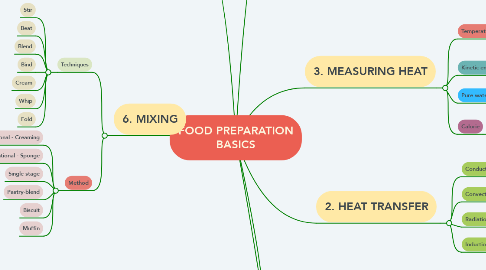
1. 4. CUTLERY TECHNIQUES
1.1. Handling knives
1.1.1. Chef's or French
1.1.2. Light task
1.1.3. Harder task
1.2. Cutting styles
1.2.1. Slice
1.2.2. Julienne
1.2.3. Shred
1.2.4. Dice/Cube
1.2.5. Mince
1.2.6. Peel
2. 5. MEASURING INGREDIENTS
2.1. Measuring techniques
2.1.1. Measuring cup
2.1.1.1. Liquid
2.1.1.2. Fat (liquid)
2.1.1.3. Sugar
2.1.2. Weight
2.1.2.1. Flour
3. 6. MIXING
3.1. Techniques
3.1.1. Stir
3.1.2. Beat
3.1.3. Blend
3.1.4. Bind
3.1.5. Cream
3.1.6. Whip
3.1.7. Fold
3.2. Method
3.2.1. Conventional - Creaming
3.2.2. Conventional - Sponge
3.2.3. Single-stage
3.2.4. Pastry-blend
3.2.5. Biscuit
3.2.6. Muffin
4. 7. SEASONING AND FLAVOURING
4.1. Salts - Sea salts, rock salts, kosher
4.2. Pepper - black, white, green peppercorns
4.3. Herbs and spices
4.4. Flavor enhancers - MSG
4.5. Marinades
4.6. Condiments (seasoning)
5. 1. TYPE OF HEATING
5.1. Moist-Heat Preparation
5.1.1. Scalding
5.1.2. Poaching
5.1.3. Simmering
5.1.4. Stewing
5.1.5. Braising
5.1.6. Boiling
5.1.7. Blanching
5.2. Dry-Heat Preparation
5.2.1. Baking
5.2.2. Roasting
5.2.3. Broiling
5.2.4. Grilling
5.2.5. Barbequing
5.2.6. Frying
6. 2. HEAT TRANSFER
6.1. Conduction
6.1.1. Direct transfer from heat contact from one substance to another
6.2. Convection
6.2.1. Transfer of heat my moving air or liquid currents through and around food
6.3. Radiation
6.3.1. Transfer of heat energy in the form of waves of particles moving from source outward
6.4. Induction
6.4.1. Transfer of heat energy without direct contact with coils
7. 3. MEASURING HEAT
7.1. Temperature scales
7.1.1. °F
7.1.2. °C
7.1.3. K
7.2. Kinetic energy
7.2.1. Energy=motion (Heat ↑ Motion ↑)
7.3. Pure water
7.3.1. Freezing point (0°C)
7.3.2. Boiling point (100°C)
7.4. Calorie
7.4.1. 1kcal=1000calories=energy used to ↑ 1g of H2O by 1°C

